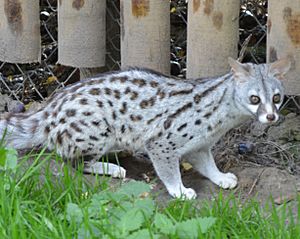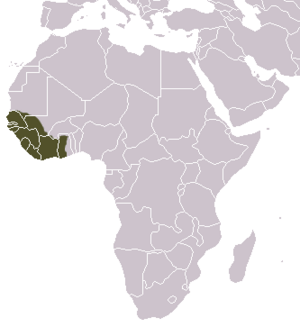Pardine genet facts for kids
Quick facts for kids Pardine genet |
|
|---|---|
 |
|
| Conservation status | |
| Scientific classification | |
 |
|
| Pardine genet range | |
| Synonyms | |
|
The pardine genet (Genetta pardina) is a cool animal found in West Africa. It is also known as the West African large spotted genet. These genets are quite common in their home. Because of this, they are listed as "Least Concern" by conservation groups. This means they are not currently in danger of disappearing.
Contents
What Does a Pardine Genet Look Like?
Pardine genets have yellowish-grey fur. They have round black spots all over their body. The spots on their back legs are bigger than those on their shoulders.
Their head is a bit more reddish. Their nose area is brownish. They have white spots under each eye and below their chin. Their ears are grey.
A pardine genet's tail is very distinctive. It has six or seven thin white rings. It also has six or seven wider black rings. The very tip of the tail is black.
Size of Pardine Genets
Adult male genets are about 410 to 553 mm (16.1 to 21.8 in) long from head to body. Their tails can be 390 to 490 mm (15 to 19 in) long.
Adult female genets are a bit smaller. They measure about 410 to 530 mm (16 to 21 in) from head to body. Their tails are usually 420 to 450 mm (17 to 18 in) long.
Where Do Pardine Genets Live?
Pardine genets live in West Africa. You can find them from Senegal all the way east to Ghana. The Volta River in Ghana might act as a natural barrier. This means they might not easily cross it.
Pardine Genet Habitats
These genets prefer to live in certain types of places. They like rainforests and gallery forests. Gallery forests are forests that grow along rivers. They also live in moist woodlands.
Sometimes, they can even be found in plantations. They might also visit the edges of towns or suburbs.
How Do Pardine Genets Behave?
Pardine genets are mostly solitary animals. This means they usually live alone. They are also active at night. This makes them nocturnal creatures.
They are very good at climbing trees. Their strong claws and long tails help them move easily through the branches.
Are Pardine Genets in Danger?
Scientists do not know of any major threats to pardine genets right now. However, their heads and skins have been seen for sale in local markets. This has happened in countries like Benin.
Pardine Genets in Zoos
You can see pardine genets in some zoos. Currently, five places in the UK keep them. These include Shepreth Wildlife Park and Wingham Wildlife Park. All Things Wild, Wild Animal Adventures, and Wild Discovery also have them.
Since 2015, Napoli Zoo in Italy has also kept pardine genets.
How Pardine Genets Are Classified
The pardine genet was once thought to be the same as other large-spotted genets. These included the Rusty-spotted genet (Genetta maculata) and the Cape Genet (Genetta tigrina).
However, scientists now know that these three are different species. Each one is recognized as its own unique type of genet.


